

We can classify optical phenomena into one of three categories: ray optics, wave optics, and quantum optics.
Light is a transverse electromagnetic wave. The energy this wave transports through space is quantized. Photons are the energy quanta or particles of light. In many situations, the wavelengths of the light being studied are very small compared to the dimensions of the equipment used to study the light, and the photon energies are much smaller than the energy sensitivity of the equipment. Under these conditions we can make an approximation called geometrical optics or ray optics. Consider the wavelength scale of light waves. Wavelengths in the middle of the visible band are on the order of 500 nm. So a laser beam with a diameter of 1 mm has a diameter of 2000 wavelengths. Individual atoms in a solid are separated by distance on the order of 0.1 nm. So, as far as visible light is concerned, matter is quasi-continuous.
If the wavelengths of the light become comparable to the dimensions of the equipment, but the photon energies are still negligibly small, then we study optical phenomena using the classical theory of radiation, or wave optics. Wave optics contains all of ray optics, but the mathematical treatment is much more involved. When the photon energies become comparable to the sensitivity of the equipment, we must study the phenomena using quantum optics.
| Diffraction is the tendency of a wave emitted from a
finite source or passing through a finite aperture to spread out as it
propagates. Diffraction results from the interference of an
infinite number of waves emitted by a continuous distribution of source
points. According to Huygens' principle
every point on a wave front of light can be considered to be a secondary
source of spherical wavelets. These
wavelets propagate outward with
the characteristic speed of the wave. The wavelets emitted by all
points on the wave front interfere
with each other to produce the traveling wave. Huygens' principle
also holds for electromagnetic waves. When studying the
propagation of light, we can replace any wave front by a collection of
sources distributed uniformly over the wave front, radiating in phase.
|
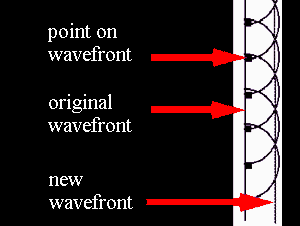 |
| When light passes through a small opening, comparable
in size to the wavelength λ of the light, in an otherwise opaque
obstacle, the wave front on the other side of the opening resembles the
wave front shown on the right..
|
|
| When light passes through a single slit whose width w is on the order of the wavelength of the light, then we can observe a single slit diffraction pattern on a screen that is a distance L >> w away from the slit. The intensity is a function of angle. Huygens' principle tells us that each part of the slit can be thought of as an emitter of waves. All these waves interfere to produce the diffraction pattern. Where crest meets crest we have constructive interference and where crest meets trough we have destructive interference. |
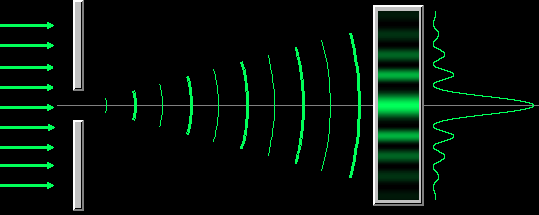 |
||||||
| Very far from a point source the wave fronts are
essentially plane waves. This is called
Fraunhofer regime, and the diffraction pattern is called
Fraunhofer diffraction. The positions of all maxima (constructive
interference) and minima (destructive interference) in the Fraunhofer
diffraction pattern can be calculated fairly easily.
The Fraunhofer approximation, however, is only valid when the source, aperture, and detector are all very far apart or when lenses are used to convert spherical waves into plane waves.
|
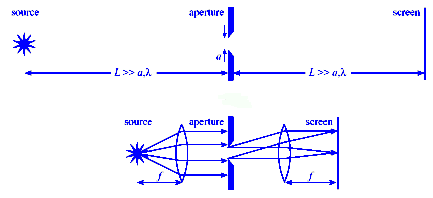 |
||||||
| The Fresnel regime is the near-field regime. In this regime the wave fronts are curved, and their mathematical description is more involved. |
|
||||||
The positions of all maxima and minima in the
Fraunhofer diffraction pattern from a single slit can be found from the
following simple arguments.
|
|
||||||
| If the optical path length of two rays differs by λ/2,
the two rays interfere destructively. For ray 1 and ray 7 to be
half a wavelength out of phase we need
(w/2)sinθ = λ/2 or w sinθ = λ. But from geometry, if these two rays interfere destructively, so do rays 2 and 8, 3 and 8, and 6 and 10, 5 and 11, and 6 and 12. In effect, light from one half of the opening interferes destructively and cancels out light from the other half. Destructive interference produces the dark fringes. Dark fringes in the diffraction pattern of a single slit are found at angles θ for which w sinθ = mλ, where m is an integer, m = 1, 2, 3, ... . For the first dark fringe we have w sinθ = λ.
When w is smaller than λ , the equation w sinθ = λ has no solution and no dark fringes are produced. |
|
||||||
| If the interference pattern is viewed on a screen a
distance L from the slits, then the wavelength can be found from the
spacing of the fringes. We have λ = w sinθ/m and sinθ = z/(L2
+ z2)1/2), or
λ = zw/(m(L2 + z2)1/2), where z is the distance from the center of the interference pattern to the mth dark line in the pattern. If L >> z then (L2 + z2)1/2 ~ L and we can write λ = zw/(mL). |
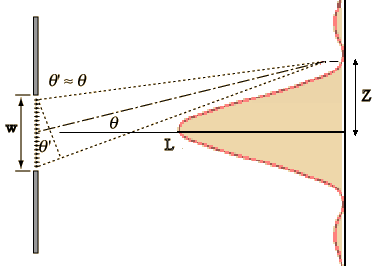 |
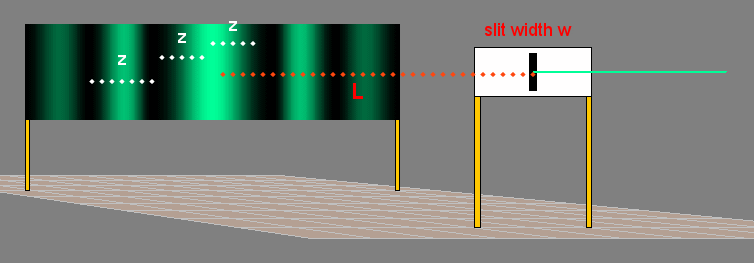
Problem:
When a monochromatic light source shines through a 0.2 mm wide slit onto a screen 3.5 m away, the first dark band in the pattern appears 9.1 mm from the center of the bright band. What is the wavelength of the light?
| Solution: z = 9.1 mm = 9.1*10-3 m L = 3.5 m w = 0.2 mm = 2*10-4 m L >> z, therefore λ = zw/(mL) λ = (9.1*10-3 m)(2*10-4 m)/(3.5 m) λ = 5.2*10-7 m = 520 nm |
![]()
| If light is incident onto an obstacle which contains
two very small slits a distance d apart, then the wavelets emanating
from each slit will interfere behind the obstacle. Waves passing
through each slit are diffracted and spread out. At angles where
the single slit diffraction pattern produces nonzero intensity, the
waves from the two slits can now constructively or destructively
interfere.
If we let the light fall onto a screen behind the obstacle, we will observe a pattern of bright and dark stripes on the screen, in the region where with a single slit we only observe a diffraction maximum. This pattern of bright and dark lines is known as an interference fringe pattern. The bright lines indicate constructive interference and the dark lines indicate destructive interference. The bright fringe in the middle of the diagram on the right is caused by constructive interference of the light from the two slits traveling the same distance to the screen. It is known as the zero-order fringe. Crest meets crest and trough meets trough. The dark fringes on either side of the zero-order fringe are caused by destructive interference. Light from one slit travels a distance that is ½ wavelength longer than the distance traveled by light from the other slit. Crests meet troughs at these locations. The dark fringes are followed by the first-order fringes, one on each side of the zero-order fringe. Light from one slit travels a distance that is one wavelength longer than the distance traveled by light from the other slit to reach these positions. Crest again meets crest. |
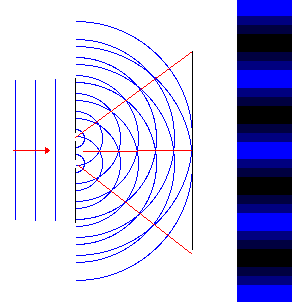 |
| The
diagram on the right shows the geometry for the fringe pattern. If
light with wavelength λ passes through two slits separated by a distance
d, we will observe constructively interference at certain angles.
These angles are found by applying the condition for constructive
interference, which is d sinθ = mλ, m = 0, 1, 2, … . The distances from the two slits to the screen differ by an integer number of wavelengths. Crest meets crest. The angles at which dark fringes occur can be found be applying the condition for destructive interference, which is d sinθ = (m+½)λ, m = 0, 1, 2, … . The distances from the two slits to the screen differ by an integer number of wavelengths + ½ wavelength. Crest meets trough. |
|
If the interference pattern is viewed on a screen a distance L from the
slits, then the wavelength can be found from the spacing of the fringes.
We have sinθ = z/(L2 + z2)1/2 and λ = zd/(m(L2
+ z2)1/2), where z is the distance from the center of the
interference pattern to the mth bright line in the pattern.
If L >> z then (L2 + z2)1/2 ~ L and we can
write
λ = zd/(mL).

![]()
| We have seen that diffraction patterns can be produced
by a single slit or by two slits.
When light encounters an entire array of identical, equally-spaced
slits, called a diffraction grating, the bright fringes, which
come from constructive interference of the light waves from different
slits, are found at the same angles they are found if there are only two
slits. But the pattern is much sharper.
The figure on the right shows the interference pattern for various numbers of slits. The width of all slits is 50 micrometers and the spacing between all slits is 150 micrometers. The location of the maxima for two slits is also the location of the maxima for multiple slits. The single slit pattern acts as an envelope for the multiple slit patterns. Diffraction gratings contain a large number of parallel, closely spaced slits or grooves. They produce interference maxima at angles θ given by d sinθ = mλ. Because the spacing between the slits is generally very small, the angles θ are generally quite large. We cannot use the small angle approximation for relating wavelength and the position of the maxima on a screen for gratings, but have to use sinθ = z/(L2 + z2)1/2. |
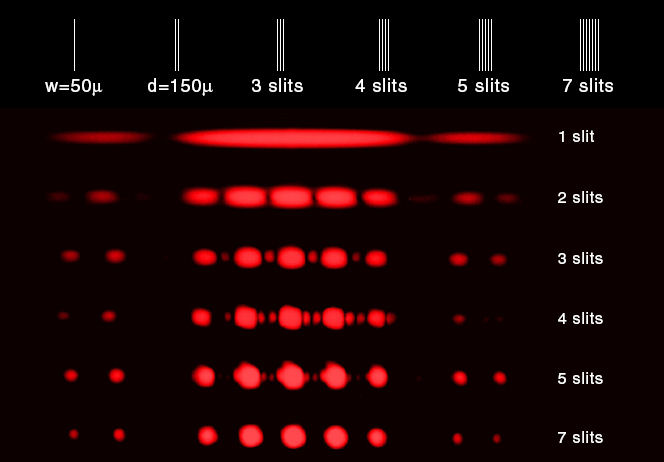 |
| Diffraction gratings disperse white light into its
component colors because different wavelengths produce bright fringes at
different angles.
dsinθ = mλ, The spectral pattern is repeated on either side of the main pattern. These repetitions are called "higher order spectra". There are often many of them, each one fainter than the previous one. If the distance between slits is d, and the angle to a bright fringe of a particular color is θ, the wavelength of the light can be calculated.
|
|
Problem:
The first order bright line appears 0.25 cm from the center bright line when a double slit grating is used. The distance between the slits is 0.5 mm and the screen is 2.7 m from the grating. Find the wavelength.
| Solution: z = 0.25 cm = 2.5*10-3 m L = 2.7 m d = 0.5 mm = 5*10-4 m L >> z, therefore λ = zd/(mL) λ = (2.5*10-3 m)(5*10-4 m)/(2.7 m) λ = 4.63*10-7 m = 463 nm |
Problem:
A diffraction grating has 420 lines per mm. The grating is used to observe normally incident light with a wavelength of 440 nm. The grating is placed 1.3 m from a screen. Where on the screen will the first order bright line appear?
| Solution: d sinθ = λ d = (1/420) mm = 2.38*10-3 mm = 2.38*10-6 m λ = 440 nm = 4.40*10-7 m L = 1.3 m = distance to the screen. sinθ = λ/d = 10.65o. z = L tanθ = 24.5 cm = distance from the central maximum. |
Problem:
A beam of monochromatic light with a wavelength of 500 nm
is directed through an absorber having 5 equally narrow slits separated by 20 μm
between adjacent slits. The resulting diffraction pattern is observed on a
screen that is perpendicular to the direction of light and 5 m from the slits.
The intensity of the central maximum is 1.3 W/m2.
(a) What are the distances from the central maximum to the first and second
principal maxima on the screen?
(b) What will be the intensity of the central maximum if there are only 4
equally narrow slits (of the same width as in part a), separated by 20 mm
between adjacent slits?
| Solution: (a) Constructive interference: dsinθ = mλ, m = 0, 1, 2, …. sinθ = z/(z2+L2)1/2 ≈ z/L if L >> z. Here d = 20 mm, λ = 500 nm, L = 5 m m = 1: sinθ = 2.5*10-2, sinθ = z/L, z ≈ 12.5 cm. m = 2: sinθ = 5*10-2, sinθ = z/L, z ≈ 25 cm (b) The central intensity is proportional to the square of the number of sources. If there are only 4 sources, then the intensity of the central maximum will be 1.3*16/25 W/m2 = 0.832 W/m2. |
![]()
Diffraction patterns can be observed when light passes through a set of regularly spaced slits. For a diffraction to produce an observable pattern, the spacing of the slits must be comparable to the wavelength of the radiation. Visible light has a wavelength range from ~400 nm to ~700 nm. A typical diffraction grating for visible light with 300 grooves per mm has a slit spacing of (1/300)mm = 3 mm = 3000 nm. This spacing is 4 to 8 times larger than the wavelengths of visible light and produces an easily observable pattern.
Interference patterns are only observed if the interfering light from the various sources is coherent, i.e. if the phase difference between the sources is constant. Splitting the light from a single source into various beams is one way to produce coherent sources. Light from two different light bulbs is incoherent and will not produce an interference pattern. Lasers are sources of monochromatic, (single wavelength), coherent light. Two lasers can maintain a constant phase difference between each other for relatively long time intervals.